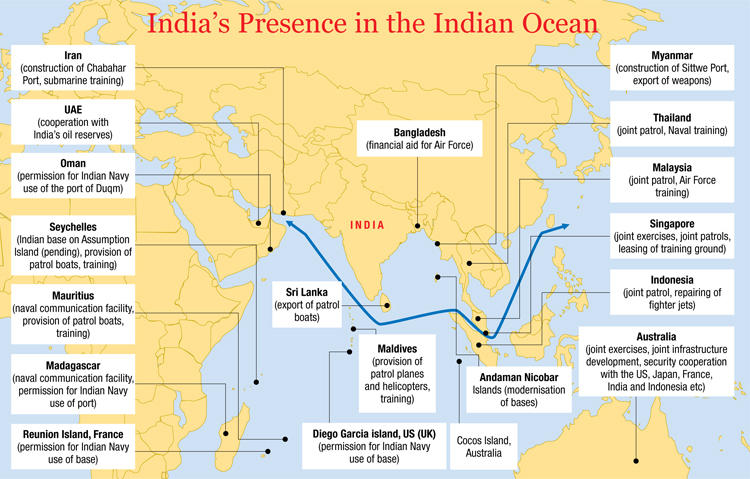International Relations
India’s Maritime Security Strategy
- 10 Jul 2020
- 7 min read
This article is based on “Shift focus to the maritime domain” which was published in The Hindustan Times on 05/07/2020. It talks about the need for India to develop a holistic maritime strategy.
Amid recent clashes between India and China over Galwan valley, Indian Prime Minister, while addressing the armed forces, held that the “era of expansionism is over”. This signalled India's stance that it will not abide by the Chinese Aggressive posture at the LAC.
Though India and China finally agreed to withdraw their troops and agreed to work for mutual peace and cooperation, India should remain wary of Chinese tactics of salami-slicing. Under this strategy, China goes for territorial expansion in small proportion through military intimidation while proclaiming its commitment to peace and tranquillity.
In this context, it is argued by many foreign policy experts that India should counter China not only in land frontiers but also in the maritime domain. Thus, there is a need for a comprehensive maritime doctrine for India.
India’s Stakes in Maritime Domain
Security Imperative: Apart from China’s aggressive posture around land borders, its military presence is growing in the Indian Ocean too. This can be depicted by the strategy of String of pearls.
- Further, China is modernising its military base at Djibouti, an artificial island in the Maldives and there are similar reports regarding Gwadar port in Pakistan.
Geo-Economics of Indian Oceans: Geopolitics is entwined with geoeconomics and its focus on matters of control and access to economic resources.
- India’s exports and imports remained mostly across the shipping lanes of the Indian Ocean. Consequently, secure Sea Lanes of Communication (SLOCs) have been a key security issue for India in the twenty-first century.
- In addition, the Central Indian Ocean Basin became the scene for deep sea exploration and licences for scarce mineral resources.
India’s Geo-strategic Location: India is centrally located between the eastern and western stretches of the Indian Ocean, thereby able to deploy naval forces in both directions more easily than other littoral states in the Indian Ocean.
- This maritime can be reflected by Milan naval exercises.
- Milan essentially became a political statement and networking exercise, showing India’s ability to take an active and leading role towards other Indo-Pacific states, unaffected by the presence of larger outside powers like the United States or China
Note:
- Milan naval exercises in the Bay of Bengal have been organized by India since 1995.
- By 2012 and 2014, these exercises involved a wide swathe of Indian Ocean actors in the shape of Mauritius, Seychelles, Maldives, India, Sri Lanka, Bangladesh, Myanmar, Thailand, Malaysia, Singapore, Indonesia, Australia, Brunei, Vietnam, and the Philippines.
Way Forward
Establishing Sagar Panchayat: India can collaborate with Indian Ocean Rim countries to establish the common good order at sea. Given India’s geostrategic location, it could sherpa a cluster of Indo-Pacific nations into a “sagar panchayat” and uphold the rule of law at sea.
Strategic Alignment: In order to secure Sea Lanes of Communication, enhancing interoperability at sea, intelligence- sharing and maintaining freedom of navigation, India should work together with like-minded nations.
- In this context, the four-nation Quad (United States, Japan, Australia and India) is a work in progress. This grouping can be expanded by including ASEAN nations.
Developing Blue-water Naval Capabilities: Given India’s stakes in Indian ocean, it is very significant for India to develop blue-water naval capabilities.
- Apart from developing indigenious naval capacity, there is a need to push for development of three aircraft carrier groups, one for each Command, and set to operate in western, southern, and eastern quadrants of the Indian Ocean.
Exploiting China’s Maritime Vulnerability: Though China has shown aggressive posture in the South China Sea and as well as Indian ocean, it has been anxious about its vulnerability at sea — or what is referred to as the Malacca dilemma.
- Taking this in cognizance, India should develop sea-denial capability mainly at choke points in Indian ocean such as Strait of Hormuz, Bab-el-Mandeb, Strait of Malacca.
Sea-Denial Capability
- Sea denial is a military term describing attempts to deny the enemy's ability to use the sea without necessarily attempting to control the sea for its own use.
Conclusion
The simultaneous rise of India and China is an important paradigm shift in the international system. This new paradigm shift will require India to focus on not only land boundaries but also maritime security.
|
Drishti Mains Question “The paradigm change in balance of power in the 21st century presents Indian Ocean as a geography of opportunity for India”. Discuss. |
This editorial is based on “A case for extension: On rural jobs scheme” which was published on July 9th, 2020. Now watch this on our Youtube channel.







